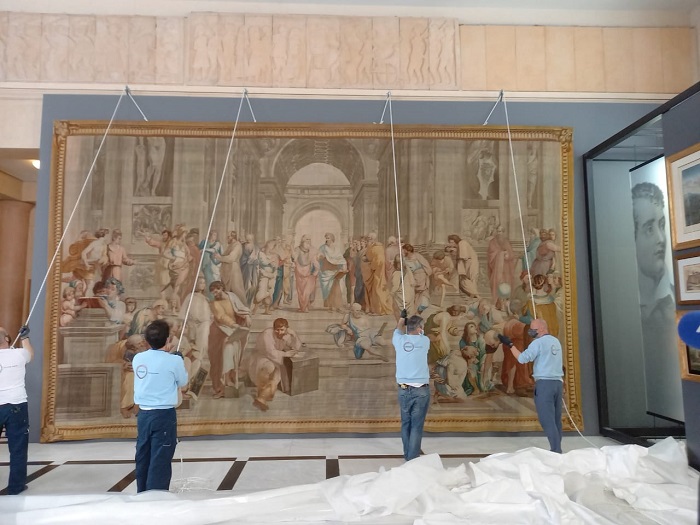
The magnificent tapestry depicting the School of Athens painting by the Italian master Raphael, which has been loaned to Greece by France, adorned the Greek Parliament on Monday.
The priceless 18th-century tapestry was sent to Athens in honor of the bicentennial of the Greek Revolution and War of Independence of 1821.
Parliamentary President Konstantinos Tasoulas and the French Ambassador in Athens, Patrick Maisonnave, attended the hanging of the tapestry on a wall in Parliament.

Showing all the great thinkers from ancient Greece, the priceless tapestry, which has for many decades hung behind French lawmakers as they deliberate legislation, is from the 17th century.
“School of Athens” shows greatest figures from Greek history
It has adorned the French National Assembly since 1879 and arrived in our country in the early hours of Monday, as a gift from the French Republic to Greece on the occasion of the 200th anniversary of the Greek Revolution.
It will be placed in the Greek Parliament.
After extensive restoration, the tapestry was revealed in all its splendor in September 2020 during a plenary session of the French Parliament.
The painting has long been considered to be “Raphael’s masterpiece and the perfect embodiment of the classical spirit of the Renaissance,” according to art historian Horst Woldemar Janson.
In his original work, the Italian master depicted some of the greatest thinkers throughout antiquity, including Aristotle, Plato, and Socrates, as well as other philosophers, as if they had all lived at the same time and were able to converse with each other.

He also portrayed sculptures of the Greek gods Athena (portrayed as the Roman goddess Minerva), representing Wisdom, and Apollo, representing Light and Music, in a direct nod to the greatness of Greek mythology and its contributions to the western world.
School of Athens contains a wealth of elements
The original painting was created between 1510 and 1511 to adorn the walls of the Vatican’s Apostolic Palace. The tapestry, which is a faithful representation of the painting, measures 4 meters (13 feet) high and 9 meters (30 feet) wide.
The School of Athens contains a wealth of elements meant to represent themes from history and how they are interwoven with each other.
One of a group of four frescoes which depict separate branches of knowledge, figures on the walls of the painting exemplify the realms of Philosophy, Poetry and music, Theology, and Law.
In his work, Raphael desired to pay his deepest tribute to the greatest philosophers in history, several of whom had tried throughout their lives to discover the prime mover, or cause, in the universe, a branch of thought called the “knowledge of the first causes.”



Comments
Post a Comment